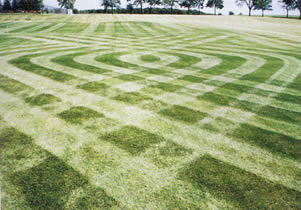 Remarkable
Patterns in Grass
Remarkable
Patterns in GrassMowing techniques for lawns, sports, and other landscapes
![]() Printable
PDF version
Printable
PDF version
If you’re a sports fan, it’s probably
no news that incredible patterns can be made in large
areas of grass. Perhaps you have even seen diamond,
abstracts, checkerboards, baseballs, waves, and other
designs on ball fields. So, how do they do that?
We’re
going to offer a basic design here, for a large scale
checkerboard that could be created across a large
lawn of ballfield. However, if you plan to create
something on this scale, we strongly recommend this
resource:
Picture
Perfect: Mowing Techniques for Lawns, Landscapes,
and Sports. Author, David Mellor. 2001. Ann Arbor
Press, Chelsea, MI.
In the book, David Mellor goes into detail about turfgrass establishment and fertilization, as well as how to’s for elaborate patterns, and perhaps most importantly, the equipment needed to create visible patterns in grass.
Ideally, a lawnmower with a roller on the back is used for this activity. The dark and light colors you see are caused by the grass being pressed down in one direction to achieve a lighter color, and then in the other direction to achieve a darker color. The roller is necessary to create this effect. You can improvise by mowing and following with a roller, but the best results will be achieved with some of the more expensive equipment used by professionals.
Don’t be discouraged, however. If you’re committed to trying one of the patterns suggested by Mellor, there may be a landscape contractor, groundskeeper, or sports turf manager in your community with the equipment needed. Perhaps this could be an ideal partnership, and one worth exploring!
In the meantime, here are the basics for producing a checkerboard pattern in grass, adapted from Picture Perfect, page 114.



